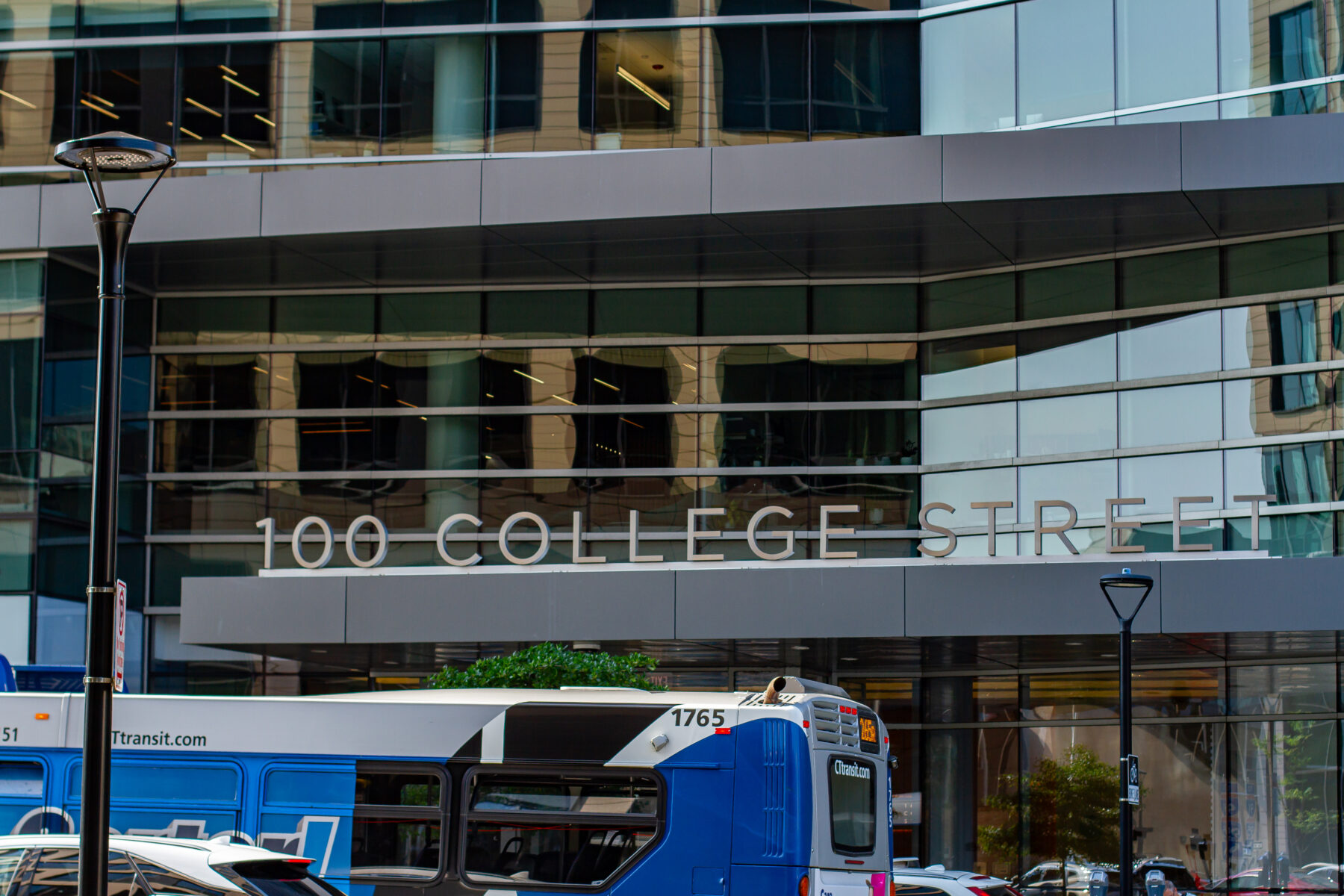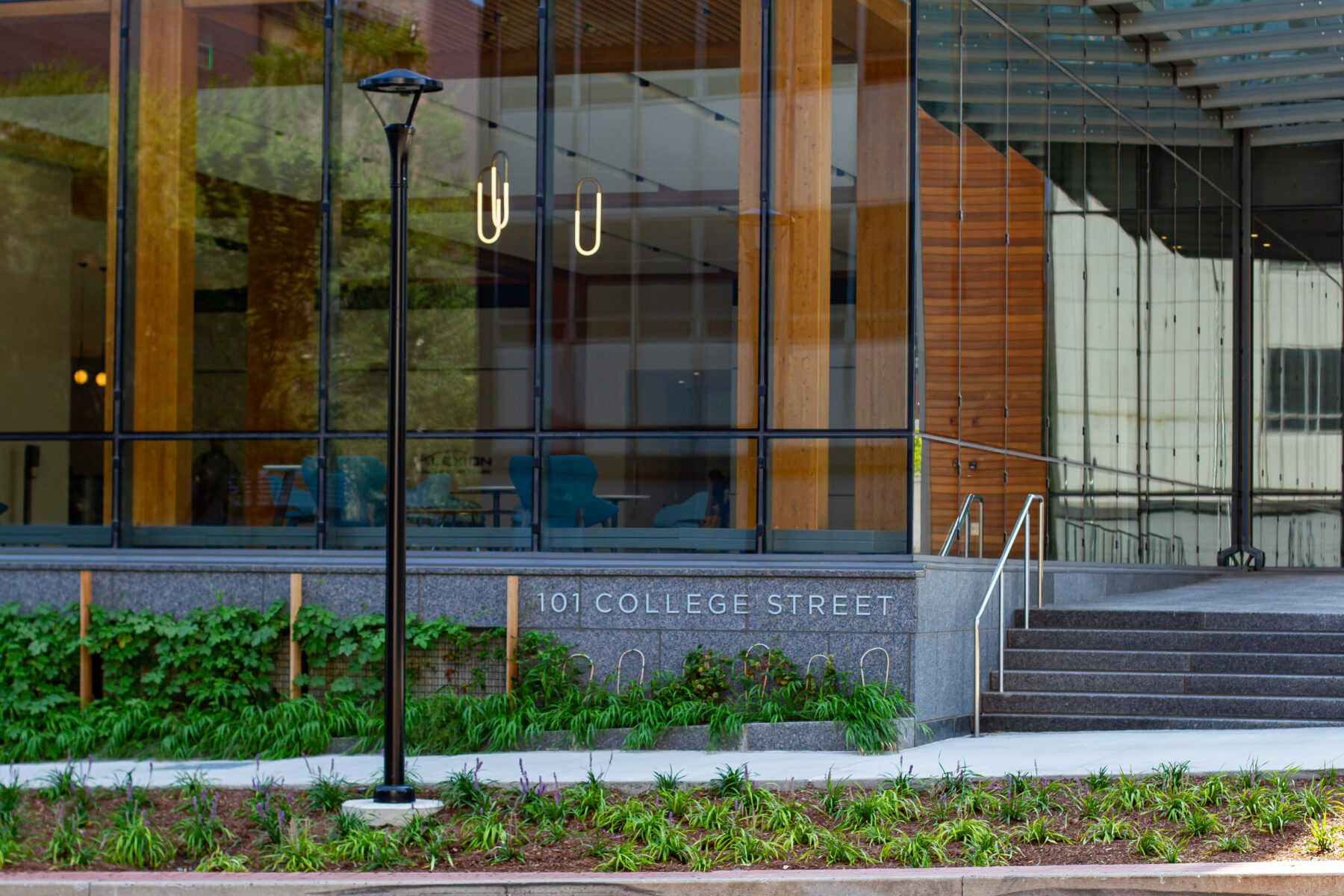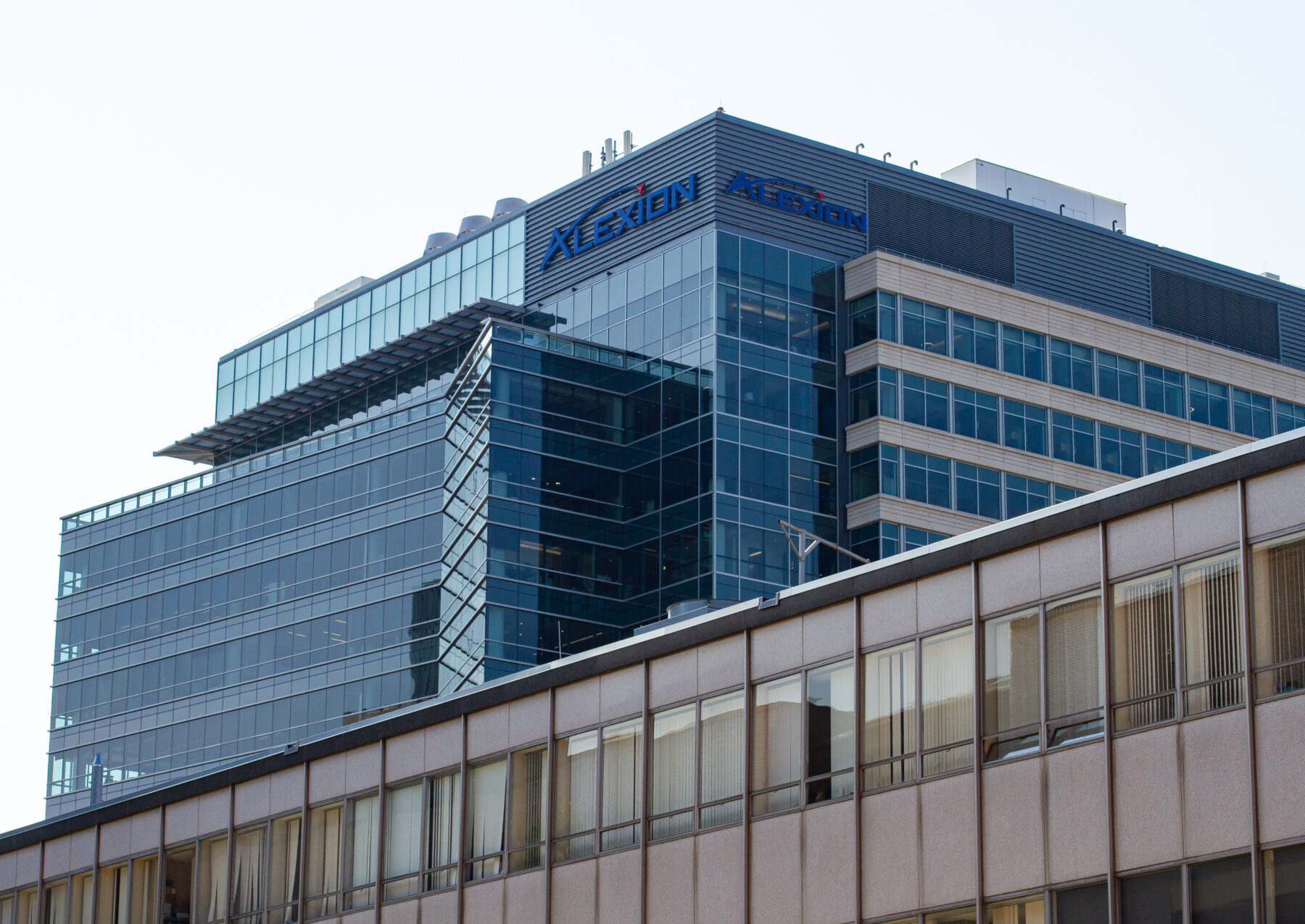Burgeoning biotech development has residents wondering: can the city avoid the mistakes of past revitalization efforts?
At 100 and 101 College Street, two opposite towers rise into New Haven’s skyline. Glimmering tinted windows conceal 1,038,000 square feet of labs and research space—a hub for the city’s burgeoning biotechnology sector. It wasn’t always like this.
Seven decades ago, former New Haven Mayor Richard Lee described this area, formerly the Oak Street neighborhood and part of the broader Hill neighborhood, as a “hard core of cancer which had to be removed.” To Lee, the neighborhood’s poverty was a disease that could metastasize and infect other parts of the city. He acted swiftly to contain it: in 1959, Oak Street became the first victim of New Haven’s federally funded urban renewal plan, which promised to bring an old, industrial city into a new economic era.
The Oak Street Connector was born. A limited access expressway designed for high-speed traffic, it aimed to extend Route 34 from Interstate 95 through New Haven, connecting the suburbs to the city. Lee hoped this plan would result in long-sought economic development. But by the 1970s, funding had dried up, and by the 1990s, construction to finish Route 34 was abandoned.
Five thousand demolished living units, 350 closed businesses, twenty-three thousand displaced people, and a mile-long “Expressway to Nowhere” stood testament to Lee’s first-line therapy. His supposed cure for “cancer” had severed the Hill neighborhood from downtown New Haven, accelerating the Hill’s decline.
Five decades later, the city again set its sights on Oak Street, this time under Mayor John DeStefano Jr. In 2010, the City won a $16 million federal grant for the Downtown Crossing Project. It would transform the Oak Street Connector from a limited access highway into an “urban boulevard” with sidewalks and businesses. The goal of the DCP was to reconnect the two parts of downtown that the highway had separated for 60 years. The grant was a significant contribution for a city with a budget of around $475 million at the time.

DeStefano assembled a team of professionals and city administrators to brainstorm ideas for redeveloping the highway to create long-term economic value. The center of that redevelopment, they decided, would be the budding biotech industry. Fueled largely by innovation from Yale researchers, biotech leverages biological research to create new medical treatments and technologies—breakthroughs that the city hoped would erupt here in New Haven.
Amid the City’s efforts to fix Lee’s urban renewal “cure for cancer,” the literal fight against human cancer and disease has become remarkably significant.
“The synergy between the growth of the [biotech] industry and the desire to remove the highway came together at just the right time,” said Michael Piscitelli, New Haven’s current Economic Development Administrator.
The city and Yale envision an economic renewal centered around biotech. But New Haven and Yale have a history of letting big-picture economic development blot out residents’ needs, as the failures of their 1960s urban renewal effort demonstrate.
The question of who will benefit from the city’s investment in biotech remains fraught. Jobs in biotech are often inaccessible to people without advanced degrees. And as expensive real estate for these firms reshapes New Haven’s skyline, some residents are left wondering if the city has pushed their need for affordable housing to the side.
In 2013, after years of planning, DeStefano initiated the demolition of the 54-year-old Oak Street Connector. “What was once a symbol of lost opportunity will again become a thriving part of our community,” he said at the time.
The question remains: as New Haven expands into a new era of urban development—largely focused on bolstering biotech—will the city repeat past mistakes of ignoring residents’ needs?
The Biotech Boom
New Haven’s recent surge in biotech traces back to 1992, when Alexion Pharmaceuticals, founded by Yale professor Leonard Bell, became the city’s first major success in the industry. In 2007, the company launched a blockbuster immunosuppressive drug, Soliris. Fourteen years later, Alexion was acquired by AstraZeneca. The company now occupies 100 and 101 College St.
“[Alexion] set the standard for the ability of our community to mature a biotech company,” Piscitelli said.
When DeStefano first stepped into office in 1994, he began to develop a partnership with then-Yale president Richard Levin, turning to the biotech industry as a potential remedy for the city’s declining economy. Ideally, the partnership would be mutually beneficial: the University would translate its research into Yale-licensed technologies, while New Haven’s economy would benefit from housing a growing, lucrative industry.
This new focus on technology transfer was formalized in 1995, when Yale tripled the budget of the Office of Cooperative Research—an entity created to translate research from Yale into products—and hired a former Pfizer executive to serve as its director. The OCR began to work closely with faculty whose research had potential commercial value to find investors. By 2000, thirteen biotechnology companies had sprung up in New Haven.
The investment in biotechnology began to physically change the city’s urban landscape. Yale hired developer Carter Winstanley to create private sector lab space for companies near the university. In 2000, Winstanley developed a nine-story biomedical research building at 300 George Street. By 2005, the space was fully leased to Yale, Yale New Haven Hospital, and a variety of biotechnology companies.
Through the recession of the late 2000s, Yale and New Haven’s new biotech machine continued to churn out new companies as the university helped its researchers monetize their work by investing in them and connecting them with venture capitalists. In 2009 alone, Yale churned out five new startups, and by 2010, the number of biotech companies in New Haven rose to around fifty. Developers raced to keep up with demand for laboratory space, and office occupancy rates rose. By then, Winstanley owned over one million square feet of commercial space between projects at Science Park and 300 George Street — but this still wasn’t enough space to support the rapid pace of new lab-space-dependent biotech research flying out from Yale.
“The pattern of history is always on our mind,” Piscitelli said. “The city paid a heavy price for urban renewal. We want to make sure we learned from that experience, that new development speaks to the future.”
Tears in the Blueprint
Still, the irony of the City’s plan—fixing one urban renewal failure with another—isn’t lost on New Haven residents, as the comments sections of New Haven Independent articles about the Downtown Crossing Project and the city’s investment in biotech suggest.
“The city should have a plan in place for a developer to build a 40-story apartment building on the future site that would be across from 101 College…where people can mostly live, but also work and play,” writes commenter @_quinnchionn_.
“New Haven has spent millions on in the past decade, correcting the work by the cities “Best and the Brightest” urban designers of yore,” writes @George Polk.
“New Haven is two cities, and I fear the growth of the industry will exacerbate the divide between them. I trust that most of the folks working in biotech are fine individuals. But I suspect few understand what it is like to live paycheck to paycheck (I don’t.) And they will be able to afford the rents in the new developments. Few New Haveners can,” writes @Kevin McCarthy.
Anstress Farwell, president of the New Haven Urban Design League, an independent nonprofit voice on planning and development issues, is also wary. When the plans for the Downtown Crossing Project came out in 2012, Farwell and the New Haven Urban Design League released a thirty-page report on its flaws, arguing that the plan does not actually serve its purpose of connecting the Hill to downtown New Haven. Further, Farwell worries that the plan prioritizes cars over pedestrians. Farwell told me that some of the designs in the final plan had changed from the original vision that won the federal grant—changes, she said, that reflected the city’s tendency to align with Winstanley’s interests.

“[Winstanley] is a facility planner, not an urbanist,” Farwell said. “He’s focused on operations, not on infrastructure and creating systems that need to be at certain standards.” She worries that Winstanley’s emphasis on parking space over sidewalks will result in “dead economic space,” as a parking garage employs hundreds less than an inhabited business and would pay less in taxes. While such parking space would accommodate suburban commuters and make new development more immediately profitable, Farwell argues that it would do little for the Downtown Crossing’s goal of reconnecting Oak Street.
Farwell showed me two maps that hung in her office: one of off-street parking in New Haven in 1951 and another of parking in 2008. The difference is stark: on the second map, the red spots indicating parking take up almost half of the page.
Over email, Winstanley wrote that he agreed with the goal minimizing parking, saying that at 101 College St. used a parking garage shared by several different buildings, and that the building had 86 percent less onsite parking than 100 College St. “While not perfect, it seems like a significant step in the right direction,” Winstanley wrote.
Keeping a parking garage out of 101 College Street made room for a public plaza, allowing people from the neighborhood to “walk right out into the space,” Piscitelli said. It aligned with the city’s goal to create what he called a “more vibrant street life.”
Flawed or not, the Downtown Crossing Project and the construction of the College Street towers have likely solidified what city historian Michael Morand described as New Haven’s new “eds and meds” economy for the future. While Morand is skeptical that a biotech surge will match the employment levels of New Haven’s old manufacturing giants such as the Winchester Repeating Arms Company, he is optimistic that the industry could provide an important base for the city’s economic development.
“The economy used to rely on manufacturing guns and weapons of war,” Morand said. “The new focus is on human health. A good transition!”
Creating a Pipeline
Employment in New Haven’s old weapons manufacturing industry generally did not require an advanced education, allowing all, regardless of education level or origin, to access jobs in the nineteenth and early twentieth centuries. Meanwhile, 90 percent of biotech jobs require at least a bachelor’s degree, according to Peter Dimoulas, grant program administrator for Southern Connecticut State University.
“That means that for the growth to benefit residents, there needs to be a strong commitment to investment in education and job training,” Morand said.
In response, the city has created several initiatives aimed at preparing New Haven Public School students for careers in biotech.
The first of these initiatives was BioPath, a non-profit partnership between the city and SCSU. In 2015, the city and the university signed a memorandum of understanding to support career advancement in the biosciences.
BioPath has developed events such as the New Haven Science Fair and other programs to help teachers understand what a career in biotech looks like and incorporate it into their lesson plans. Funding for BioPath has come from industry partners like Alexion. The goal is to create pipelines for students from New Haven Public Schools to jobs in biotech.
“We need to make sure that we’re not selling them a pipe dream,” Dimoulas said.
During 101 College Street’s development, Winstanley decided to place a classroom in the center of the building, which has become an integral part of BioPath’s BioCity program. The program selects a cohort of high school juniors from four New Haven public schools for a biotech career training series.
“The program’s goal is to get real life exposure to what science is really like,” said Robert McCain, science supervisor for New Haven Public Schools. “Hopefully [students] go into biosciences as their major, and give back to New Haven by getting a job here, because there’s so many bioscience openings.”
McCain hopes to expand the program, but its grant funding—$1.5 million from the American Rescue Plan and $1.5 million from the Department of Education—will run out in three years. He’s looking for different ways to find the money needed to continue the program, but he knows it will be a challenge.
“When we started researching, we were trying to model ourselves after someone who’d already done this, but we couldn’t find any places that have done anything like this in a large urban city,” he said.
Since 2021, BioPath has secured over 150 job and internship placements. BioCity hopes to reach seventy-five students over the next three years. BioLaunch, another similar program headed by Craig Crews, a Yale professor and the founder of biotech company Arvinas, has cohorts of thirty individuals each academic year. The numbers are not huge, but they’re a “proof of concept” that needs to be established; then, hopefully, they will scale up, Piscitelli told me.
Katherine Perez, an alumni of Wilbur Cross High School and SCSU, told me how SCSU’s guidance in helping place her in a biotech internship with Medtronic “opened [her] eyes to see what’s out there.” After completing a masters degree in physics, she returned to Wilbur Cross, where she had just finished her fifth year teaching an early college credit class to help high school students get a head start on their careers.
Melanie Burgos, who grew up in New Haven and also attended SCSU, told me that her BioPath mentorship helped place her in an internship and inspired her to found the “Latinx in STEM” club at the university.
“The truth is, you need the experience, the research, all these things to succeed all while managing college. It’s so difficult, and [Dimoulas’ team] allowed us to find those opportunities. In my wildest dreams, I never would have thought I would have the opportunity to actually do research in a lab,” Burgos said.
She served as a panelist for the first two years of BioPath’s Connecting Students and Professionals of Color events—events that she said have allowed her to connect with industry professionals like Alexion, Boehringer Ingelheim, and Pfizer.

As the city works with Yale and the biotech industry to mend their historical failures and move past their old industrial economy, they will need to replicate success stories like Perez and Burgos’. A successful new biotech economy will bring money back into the city, but could also raise the rent for those living in New Haven when affordable housing is already scarce.
The city has plans to continue housing development in places such as Pierpoint and Church Street South and insists that their focus on developing on parking lots and vacant land reduces the displacement of residents from their homes. But renters still confront rising rents, and locals may find themselves excluded from the biotech job market in the city’s search for a cure.
“A rising tide lifts all ships.” said Dimoulas. “But the question that remains is: are the opportunities in New Haven also for New Haven? Can the average student from New Haven, Hamden, West Haven—can they gain meaningful employment among these companies?”
On most days, people in suits stream in and out of the College Street buildings. Dimoulas wonders if, in a decade, students from New Haven public schools—perhaps from the Hill—may find themselves among them.
– Tobias Liu is a junior in Trumbull College.
Photography by Gavin Guerrette.

